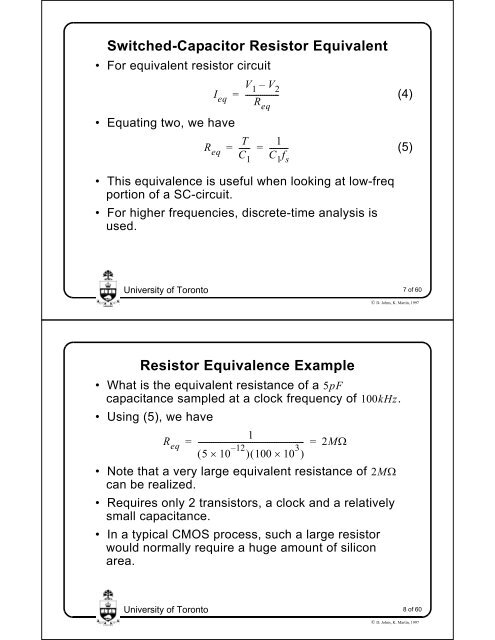Switched-Capacitor Circuits - University of Toronto
Switched-Capacitor Circuits - University of Toronto
Switched-Capacitor Circuits - University of Toronto
Create successful ePaper yourself
Turn your PDF publications into a flip-book with our unique Google optimized e-Paper software.
<strong>Switched</strong>-<strong>Capacitor</strong> Resistor Equivalent<br />
• For equivalent resistor circuit<br />
• Equating two, we have<br />
• This equivalence is useful when looking at low-freq<br />
portion <strong>of</strong> a SC-circuit.<br />
• For higher frequencies, discrete-time analysis is<br />
used.<br />
<strong>University</strong> <strong>of</strong> <strong>Toronto</strong><br />
<strong>University</strong> <strong>of</strong> <strong>Toronto</strong><br />
I eq<br />
R eq<br />
=<br />
V1 – V2 -----------------<br />
R eq<br />
T<br />
= ----- =<br />
C 1<br />
1<br />
----------<br />
C1fs Resistor Equivalence Example<br />
(4)<br />
(5)<br />
7 <strong>of</strong> 60<br />
© D. Johns, K. Martin, 1997<br />
• What is the equivalent resistance <strong>of</strong> a 5pF<br />
capacitance sampled at a clock frequency <strong>of</strong> 100kHz.<br />
• Using (5), we have<br />
R eq<br />
1<br />
5 10 12 –<br />
100 10 3<br />
= -------------------------------------------------------- = 2M<br />
<br />
• Note that a very large equivalent resistance <strong>of</strong> 2M<br />
can be realized.<br />
• Requires only 2 transistors, a clock and a relatively<br />
small capacitance.<br />
• In a typical CMOS process, such a large resistor<br />
would normally require a huge amount <strong>of</strong> silicon<br />
area.<br />
8 <strong>of</strong> 60<br />
© D. Johns, K. Martin, 1997














